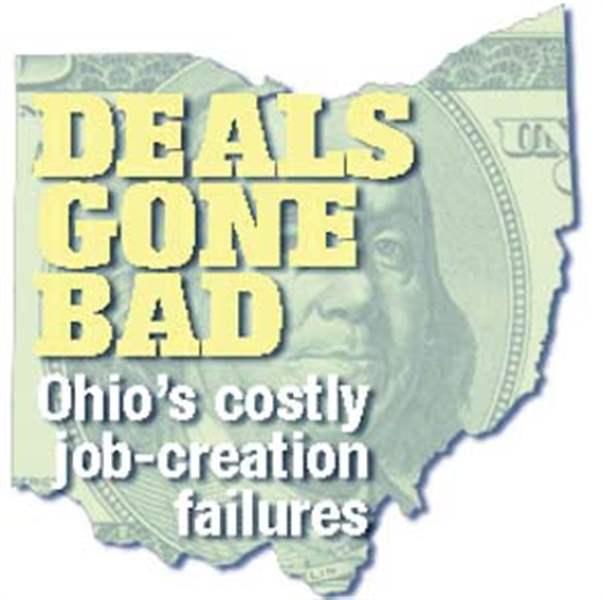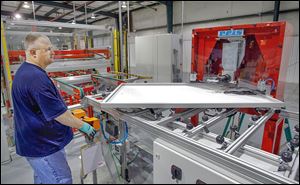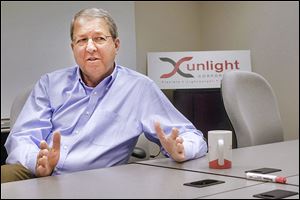
DEALS GONE BAD
Solar firms prove costly investments
Tens of millions wasted on fledgling industry
12/1/2013

Kevin Morris uses a machine to crimp the corners of a 250 watt solar panel frame at Isofoton’s $31 million factory in Napoleon. In total, Isofoton North America garnered $8.4 million in local and state incentives.
Editor's note: This story corrects the amount of public funding used by First Solar Inc.

One in a series
Five years ago, government and local economic development officials made the costly decision to invest in northwest Ohio’s fledgling solar industry.
Loans, grants, and tax credits worth more than half a billion dollars were doled out to businesses that promised to create almost 1,000 jobs and rejuvenate the region’s manufacturing base.
Public officials — eager to capitalize on that momentum — pushed through subsidies and passed legislation that benefited solar companies. Big-name politicians such as Vice President Joe Biden and former Gov. Ted Strickland, both Democrats, visited solar factories to tout job creation.
The incentives, legislation, and stump speeches were part of a narrative that the Toledo region had become a major player in the solar industry. That tale, however, did not have the happy ending business owners and politicians hoped for: Most of the jobs companies projected were not created, and tens of millions of dollars were wasted.
A Blade investigation of solar companies in northwest Ohio that received financing from the government or local economic development agencies reveals it took more than $611,000 on average to create each job at solar start-up firms.
Those businesses, which received more than $88 million, currently employ 144 people. The start-ups expected to hire more than 900 additional workers.
Many of the companies that received money either closed their doors or only have about a dozen people on staff.
First Solar Inc., a Tempe, Ariz., business that was founded in Toledo by inventor Harold McMaster, received $27.1 million in government assistance. The company, which is the largest global manufacturer of thin-film solar panels, aggressively ramped up its operations at its Perrysburg Township factory during the past decade. Its work force soared from 156 in 2002 to 1,296 in 2011.
Although First Solar is one of the global solar industry’s largest players, it has laid off 94 employees since 2012. The 380 jobs the company added since 2008 are worth about $71,444 per job when divided against the millions the firm received in public funds.
Toledo’s Buckeye Silicon received $2.7 million from the state of Ohio but never had more than two employees on site during visits from The Blade.
Government and local economic development officials chose solar power as a winning industry, but they did so at a great price to taxpayers and themselves.
“It’s clear that a lot of politicians feel a strong urge to try to give industry-specific or firm-specific incentives,” said Charles Ballard, an expert at Michigan State University who specializes in Rust Belt economics. “Elected officials love photo ops and press releases. It’s very easy to say, ‘We gave a company this incentive and it is going to bring jobs.’
“It’s not as easy to go back five years later, and these companies have not produced jobs.”

Xunlight Corp. President John Buckey says the changes the company plans will cut its costs by 38 percent and decrease its production time. The firm has failed to pay some of its vendors and has struggled to fill orders.
Signs of failure
Drive past Perrysburg’s Willard & Kelsey Solar Group, and the failure of northwest Ohio’s solar industry is on full display: The company’s hulking 200,000-square-foot plant is idle. The solar-panel manufacturer closed at the end of June.
The struggles of solar companies extend beyond the doldrums of the recession and the fierce competition that Chinese manufacturers brought to the solar-panel market, which drastically decreased prices in the past few years. Some firms received funding before their technology was fully developed, others didn’t have a solid business plan, and a few were grossly mismanaged.
Willard & Kelsey, which received $14.2 million in government tax breaks, loans, and grants, promised to create 400 jobs when it requested financial assistance from the state of Ohio. The firm laid off most of its staff in January, 2012. State officials who were responsible for keeping tabs on Willard & Kelsey were unaware of the layoffs.
A Blade investigation published in October revealed the state is often unaware whether business incentives create jobs and if companies properly use the funding they receive.
According to internal payroll records obtained by The Blade, Willard & Kelsey had 39 employees throughout 2009. Those workers were paid an average of about $38 an hour, or about $78,582 a year. In turn, each of those positions — funded with local and state incentives — cost $364,102 to create.
Willard & Kelsey’s executives paid themselves millions and spent tens of thousands of dollars on lavish corporate expenses. Records maintained by the firm’s former chief executive officer also stated that Willard & Kelsey misappropriated a $5 million state loan.
A state audit released in July found the business could not account in detail for how it spent $1.3 million of its state loan funds. The state filed two lawsuits in August against Willard & Kelsey seeking more than $10 million in damages. The lawsuits include two counts of fraudulent and unlawful transfers, two counts of civil conspiracy, and two counts of civil aiding and abetting.
The lawsuits filed in Hamilton County Commercial Court have been scheduled for a pretrial hearing in July.
Lyn Tolan, deputy director of communications and policy for the Ohio Development Services Agency, declined to comment on Willard & Kelsey. The agency provided the firm with $5.6 million in grants and a loan and monitors how state funding is used.
The Blade reached out to Republican Gov. John Kasich’s office for an interview, but Mr. Kasich’s spokesman did not respond to the request. The governor’s office has refused to discuss breakdowns in the way Ohio manages and tracks business incentives. It has shirked interview requests from The Blade for the past two months.
Buckeye Silicon’s story is almost identical to Willard & Kelsey’s. The polysilicon manufacturer has been accused of fraud in a lawsuit filed by Ohio Attorney General Mike DeWine, who is trying to recoup a $2.7 million state loan.
The company pledged to create nine jobs, but only had two people on staff this fall. Those positions cost Ohio taxpayers $1.36 million apiece.
It’s unlikely that the state will recover the money it lent to Buckeye Silicon.
“These loans should not have been made and should have been serviced better,” said Jeff Jacobson, vice chairman of the Ohio Air Quality Development Authority, which awarded loans to both Buckeye Silicon and Willard & Kelsey. “We should have cut our losses when we realized the state of the industry and the inability of the players we were doing business with to make a go of it.”

Jim Fisher and Pam Reynolds assemble solar panel components for production at the Toledo-based Xunlight’s manufacturing facility. Xunlight is overhauling its manufacturing process to meet its customers’ demands.
Reversal of fortune
Isofoton North America, which scouted several locations in the United States, settled on building a $31 million solar-panel factory in Napoleon after the state agreed to finance part of the project. In total, the firm garnered $8.4 million in local and state incentives.
The Spanish solar-panel manufacturer planned to hire 330 people. Napoleon was named “America’s Number One Solar Small Town” by the Washington-based Solar Energy Industries Association in December, 2012, because of Isofoton’s presence.
The accolade, though, was premature. Just one month later, the order Isofoton needed to jump-start its plant fell through.
Isofoton’s North American business plan hinged on approval of the now-defunct $180 million Turning Point Solar Project, which was planned for Zanesville, Ohio, about 60 miles east of Columbus. It would have been the largest solar-panel development east of the Mississippi River. The project has been dead in the water since the Public Utilities Commission of Ohio rejected a proposal to finance Turning Point with fees charged to American Electric Power customers.
“We didn’t anticipate or expect the PUCO decision,” said Michael Peck, chairman of Isofoton North America. “You could criticize us for that.”
The company has about 20 employees and runs one shift. Each job cost about $419,079 in assistance to create.
Mr. Peck said Isofoton North America has been hard-pressed to find financial backers, particularly after its parent company entered into involuntary receivership in Spain. Isofoton North America is required to raise more capital by this month, per an agreement Mr. Peck reached with Ohio development officials.
“It’s incumbent upon us, as a private-sector entity, to prove the private-sector viability of what we are doing,” Mr. Peck said. “The state is not a charity.”
The company owes a quarterly, interest-only payment of $25,400 to the state air authority this month. It is due to start payments on the principal and interest in March. The company also owed a payment of $44,793 to the Ohio Development Services Agency last month. The agency, which loaned Isofoton $3 million, deferred most of the firm’s payments from July to this month.
All of the firm’s state funding was granted by the Kasich administration.
If Isofoton doesn’t receive more orders and increase its production, repaying the state funds will be extremely difficult, Mr. Peck said.
“I would say that we kind of had our legs kicked out from underneath us and we’re recovering,” he said.
Toledo’s Xunlight
Staying financially afloat is paramount at Toledo’s Xunlight Corp., which has not turned a profit since its 2006 founding.
Xunlight, which produces lightweight, flexible solar panels, has struggled to fill its orders in a timely manner. It is overhauling its manufacturing process to meet its customers’ demands, said John Buckey, the firm’s president.
The changes will cut Xunlight’s costs by 38 percent and decrease its production time from about three hours to half an hour, Mr. Buckey said. Xunlight also will eliminate the need to ship materials to and from an assembly plant in China, he added.
Xunlight was born from research conducted at the University of Toledo. Its solar panels have provided power to United States military tents and mobile power stations in developing countries.
The firm has about 70 employees and received $52.5 million in loans, grants, and tax credits. Those jobs cost $749,673 per position, and Xunlight employees make $31,200 a year plus benefits.
The company was unable to live up to its original job-creation requirement of 181 jobs, and the state approved a February, 2011, request to reduce that requirement to 40 positions.
One of the company’s biggest problems was it tried to commercialize its technology before it was ready, said Rick Stansley, head of the University of Toledo Innovation Enterprises, which invested $3 million in Xunlight. UTIE had to write off $1 million of that investment as a loss.
“What ended up happening is that process of moving this from an experiment to commercialization took them longer than they expected,” Mr. Stansley said. “They had scaled up for production based on their technology, which may have not come to fruition.”
There was another issue with an investment in Xunlight: The company missed slightly more than $193,000 in payments due in February and May, 2012, on a $5 million state air authority loan. Those missed payments prompted the air authority and the Ohio Development Services Agency, from which Xunlight borrowed $3 million, to defer the firm’s loan payments until next year.
“The payments are pretty reasonable,” Mr. Buckey said. “I don’t see them making a big difference in our monthly cash flow.”
Even though most of Xunlight’s funding was granted under Governor Strickland, its loan payments were deferred by Governor Kasich’s administration, which also was responsible for slashing the company’s job-creation requirement.
Although Xunlight was given a grace period by the state, the firm has failed to pay some of its vendors and is being sued for $553,782 by MRR Inc., a Toledo temporary employment agency that helped Xunlight staff its plant.
Dennis Kebrdle, Xunlight’s chief transition officer, declined to discuss the lawsuit and refused to say how much the company owes its other vendors.
“It is what it is. It was our biggest vendor,” he said of the half-million-dollar lawsuit.
A pricey success
Although solar businesses failed and others continue to face financial hardships, some companies, such as SoCore Energy, did exactly what they pledged to do. SoCore installed solar panels on Walgreens pharmacy rooftops across Ohio after receiving more than $5 million from the air authority.
The project, however, was pricey for taxpayers. It created four permanent jobs that, based on total assistance, cost $1.29 million each. SoCore, based in Chicago with an office in Maumee, requested $3.3 million of its loan be forgiven. The state has forgiven $1.1 million so far.
“In addition to creating the required jobs, the loan made it possible for SoCore to contribute to economic development in Ohio,” SoCore President Pete Kadens wrote in an email to The Blade.
Ohio and solar
Craig Winn, president of Applied Energy Technologies, said Ohio’s solar market isn’t a boon for his firm, which targets projects in states that offer hefty incentives to solar companies.
Applied Energy Technologies, a producer of solar-panel support racks, was awarded a $210,000 grant from Ohio in 2012. It has received $18,350 of that funding thus far. The company is based in Clinton Township, Michigan, and has a facility in Maumee. It is staffed with about 12 people when it’s running one shift, which is the norm because the most lucrative federal solar incentives have expired.
“Our basic premise is to go where the business is and to look at state legislatures and see what’s coming in,” Mr. Winn said. “We also look at what measures are sunsetting because then the business dies.”
Mr. Winn said solar energy will take much longer to take root in the Midwest because the region’s fossil-fuel costs are low. The solar markets are hottest in the West and Northeast, which have some of the country’s highest energy costs, he said.
Although Ohio boasts its solar energy capacity, it doesn’t rank among the top 10 states for connected solar installations, according to a July report from the Interstate Renewable Energy Council. Ohio came in 15th place; the top states included California, Arizona, and New Jersey.
Less than 0.01 percent of Ohio’s renewable energy came from solar power in 2011, according to the U.S. Energy Information Administration’s most recent data.
A bill proposed in the Ohio General Assembly could drastically change Ohio’s renewable-energy portfolio. The legislation would create exceptions to a 2008 law requiring state utilities to purchase half of their renewable energy from in-state sources by 2025.
For business owners, it’s another reason to look elsewhere for work in the solar industry.
“There’s not enough work in Ohio for me to justify putting sales work into it,” Mr. Winn said.
Kris Turner can be reached at: kturner@theblade.com or 419-724-6103.